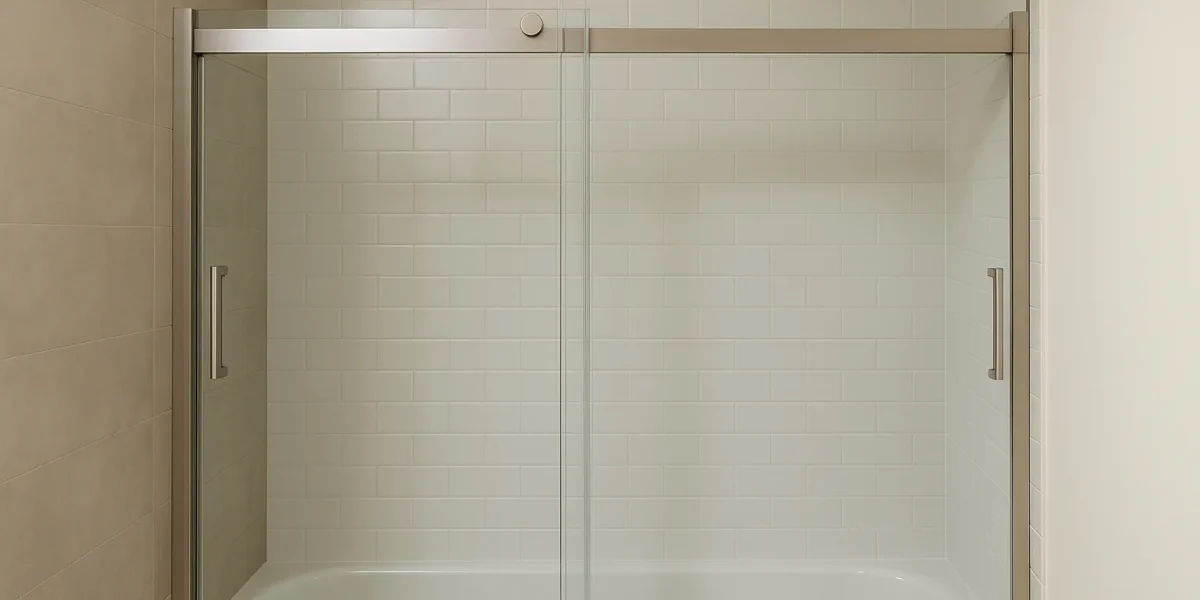Sliding shower doors are one of those little luxuries that make a bathroom feel polished, modern, and easy to use. They’re sleek, save space, and add a touch of elegance to your daily routine. But if you’ve ever wondered how to actually work with them—whether it’s installing, cleaning, fixing, or even replacing them—you’re not alone. The good news? You don’t need to be a professional contractor or own a tool belt to get comfortable with the basics. This guide breaks it down step by step, with a beginner-friendly approach that keeps things practical and stress-free.
How to Install Sliding Shower Doors
Installing sliding shower doors might sound intimidating, but when you understand the concept, it feels far less complicated. At its core, it’s about fitting panels of glass (or acrylic) into a frame or track that lets them glide smoothly.
The first thing to know is that the frame or track usually sits on top of the tub edge or shower curb. It’s like a little “railroad” where your doors ride back and forth. One door overlaps the other so you can slide them open and closed.
For a beginner, the most important part of installation isn’t the tools—it’s the patience. Think of it as a puzzle: lining up the frame, making sure the doors are level, and testing the movement before tightening things into place. If you’ve ever built flat-pack furniture, this process will feel familiar. The pieces are designed to fit together, and as long as you follow the instructions slowly, you’ll get there.
Steps to install sliding shower doors:
- Place the bottom track along the shower curb or tub edge. Make sure it sits evenly.
- Fit the side rails into position so they connect with the base.
- Attach the top track so everything forms a frame.
- Carefully set each glass panel into the bottom track and guide the tops into the rollers.
- Slide each door back and forth to test movement. Adjust until they glide smoothly.
- Secure the frame in place, double-checking for balance.
Here’s the mindset: focus on keeping everything straight, balanced, and secure. Once the track is in place, the panels just slide in like magic. The final touch is making sure the doors glide easily without wobbling.
How to Clean Overlapping Sliding Shower Doors
Sliding shower doors are gorgeous, but if you’ve ever dealt with the overlapping section where two doors meet, you know it can be a hotspot for soap scum and water spots. The trick? Approach it like you’re cleaning layers.
Start by sliding one door to one side and giving the exposed edge a gentle wipe. Then, slide the opposite door over and do the same. The overlapping track often has tiny crevices that collect water and grime, so it helps to run a cloth or sponge along that hidden channel.
For the glass, the simplest approach is often the best: warm water mixed with a little mild soap works wonders. Wipe in circular motions, then finish with a dry cloth to avoid streaks. If you’ve got stubborn buildup, a mixture of equal parts vinegar and water is a lifesaver—it cuts through the haze without harsh scrubbing.
Steps to clean overlapping doors:
- Slide one door all the way to one side.
- Wipe down the exposed glass edge with a damp cloth.
- Switch the door position and repeat for the other side.
- Use a cloth or sponge to run along the overlapping track where grime hides.
- Mix equal parts vinegar and warm water for stubborn buildup.
- Dry with a soft cloth to keep streaks away.
Cleaning overlapping doors is really about consistency. A quick wipe a few times a week keeps you from ever having to deal with a major deep-clean later.
How to Remove Sliding Shower Doors
Maybe you’re renovating, maybe you’re swapping styles, or maybe you just want easier access for cleaning. Removing sliding shower doors is surprisingly doable.
Picture it this way: the doors sit in a track, like a closet door. To remove them, you lift them slightly and angle them out. Sometimes the top track has a small lip or guide that needs to be shifted, but overall, the process is less about force and more about gentle maneuvering.
If you’re dealing with a frame, the side pieces may need to be loosened so the doors can slip out. Once that’s done, the glass panels are surprisingly light (though still fragile—always handle carefully). With the panels out, the frame or track can usually be lifted off in sections.
Steps to remove sliding shower doors:
- Slide one door to the side so you can reach it.
- Lift the panel gently upward to release it from the bottom track.
- Angle the bottom outward and ease the panel free.
- Set it aside on a towel or blanket to protect it.
- Repeat with the second panel.
- Once panels are out, lift off the top and bottom tracks if needed.
For a beginner, the key takeaway is this: don’t rush. Move one panel at a time, and keep a towel or soft blanket nearby to rest the glass on once it’s free. That way, nothing gets scratched or chipped.
How to Install Sliding Shower Doors on a Tub
Tub-and-shower combos are everywhere, and sliding doors are a great way to upgrade them. The main difference from a stand-alone shower installation is that the frame sits directly on the tub’s edge instead of a tiled curb.
Because the tub has a curved lip, it’s extra important to ensure the track rests flat. Even a tiny tilt can cause water to escape or make the doors slide unevenly. Once the bottom track is balanced, the rest of the process feels just like installing on a shower: secure the frame, slide the panels in, and check the movement.
Steps for installing sliding doors on a tub:
- Place the bottom track directly on the tub edge.
- Ensure the track sits flat (no tilts or gaps).
- Position side rails so they meet the base securely.
- Snap or attach the top track across the top.
- Slide glass panels into the bottom rail and guide them into place at the top.
- Test the movement of both panels, adjusting if one drags.
The result is instantly transformative. A tub with sliding doors feels modern, sleek, and much more spa-like than a traditional curtain. It also eliminates the daily annoyance of wet fabric sticking to you mid-shower.
How to Fix Sliding Shower Doors
Over time, even the smoothest doors can get a little cranky. Maybe they stick, wobble, or squeak. Don’t worry—most issues are minor and beginner-friendly to fix.
If the doors feel heavy or drag, the culprit is often dirt or soap buildup in the track. A quick clean usually restores the glide. If one panel feels loose, it’s often because the rollers at the top have shifted slightly—think of them like tiny wheels that just need a gentle nudge back into place.
Sometimes the doors won’t close evenly, leaving a gap where water escapes. This usually means the frame is a bit off balance. In many cases, simply adjusting the rollers higher or lower on one side can even things out.
Steps to fix common sliding shower door issues:
- If doors stick, clean out the bottom track to remove soap or dirt.
- If a door wobbles, check the rollers at the top—adjust or realign them.
- If doors won’t close evenly, raise or lower one roller to balance the panel.
- Test by sliding both doors fully open and closed until smooth.
- Wipe down tracks regularly to prevent the same issue from coming back.
Here’s the beginner’s perspective: fixing sliding shower doors is rarely about replacing big parts. It’s usually about cleaning, adjusting, and re-balancing. Small tweaks go a long way.
How to Replace Sliding Shower Doors
Replacing sliding shower doors feels like a big project, but it’s really just two smaller steps: removing the old ones and installing the new. You’ve already learned both those skills.
The biggest decision here is style. Do you want frosted or clear glass? Brushed metal or polished chrome frames? Frameless doors for a sleek, hotel-like vibe? Once you’ve chosen the design, the actual swap feels straightforward.
Steps to replace sliding shower doors:
- Remove the existing panels by lifting them out of the track.
- Take off the frame or tracks if you’re upgrading the whole system.
- Clean the tub edge or shower curb thoroughly before adding new pieces.
- Install the new frame just like in the installation section.
- Slide the new glass panels into place, making sure they glide evenly.
- Step back and admire your fresh new bathroom look.
When replacing, always take a moment to clean the tub edge or shower curb before installing the new frame. It’s like starting with a blank canvas. Fresh doors look best when paired with a spotless foundation.
Extra Tips for Sliding Shower Door Success
Because this guide is all about beginner confidence, here are a few bonus insights:
- Consistency beats intensity. Wiping down the doors often prevents tough cleaning sessions later.
- Patience is part of the process. Whether installing or fixing, moving slowly avoids mistakes.
- Style matters. The right doors can completely change the mood of a bathroom—sometimes more than paint or tile.
- Don’t overthink it. Sliding doors are designed for everyday people, not just pros.
Final Thoughts
Sliding shower doors can seem intimidating if you’ve never worked with them, but once you break down the steps, they’re surprisingly approachable. Whether you’re installing, cleaning, fixing, or replacing, the process is more about steady hands and attention to detail than special skills. Think of it as a series of small, manageable steps—each one leading you toward a bathroom that feels cleaner, sleeker, and more functional.
With the right mindset, your shower doors don’t just slide—they glide.
Frequently Asked Questions (FAQs)
Yes. Sliding shower doors are designed with tempered glass, which is stronger and safer than regular glass.
When installed properly, they’re designed to keep water in. If leaking happens, it’s usually from an uneven track or old seals.
Most standard tubs can support sliding doors, but it’s important that the edges are flat and level for the track to sit securely.
A quick wipe two to three times a week prevents soap scum. A deeper clean once a month keeps them sparkling.
Framed doors have metal edging around the glass, while frameless designs use thicker glass and create a sleek, modern look.
Usually, yes. If one panel breaks or gets damaged, you can replace it without changing the entire system.


